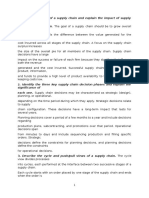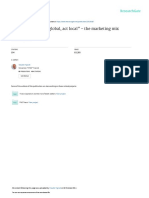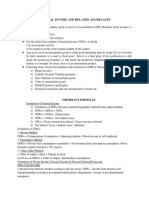The Supply Chain Cycle and The Location of The Push/pull Boundary
The Supply Chain Cycle and The Location of The Push/pull Boundary
Uploaded by
Ahmed HossainCopyright:
Available Formats
The Supply Chain Cycle and The Location of The Push/pull Boundary
The Supply Chain Cycle and The Location of The Push/pull Boundary
Uploaded by
Ahmed HossainOriginal Title
Copyright
Available Formats
Share this document
Did you find this document useful?
Is this content inappropriate?
Copyright:
Available Formats
The Supply Chain Cycle and The Location of The Push/pull Boundary
The Supply Chain Cycle and The Location of The Push/pull Boundary
Uploaded by
Ahmed HossainCopyright:
Available Formats
The interface between the push based and pull based stages of the supply chain is
sometimes called the push/pull boundary. The boundaries vary from company to company
based upon their supply chain strategies.
In Amazon’s case, they outsource inventory management since over 50% of Amazon’s sales
are from 3rd Party sellers and in-source logistics in order to have direct control over when
orders are delivered to customers. Their delivery options are a strategic differentiator and a
major critical success factor.
In support of the delivery options, depending on the product, Amazon order fulfillment
either taps into:
· its 3rd party supplier network, following a pull strategy to fill orders, or
· its vast network of warehouses that are sized and placed near cities and main
metropolitan areas using a push strategy to stock the warehouses.
§ Amazon relies on regional forecasts by product class to manage warehouse stock levels.
§ The warehouses are organized into five storage areas or zones, which group products
within the region based on customer order patterns.
o Its library prime storage stores books and magazines.
o Next, its pallet prime storage stores full-case products that have very high demand.
o Next, case flow prime storage stores high-demand products picked in less-than-case
quantities.
o Its reserve storage accommodates irregularly shaped and low-demand products.
o Finally, its random storage area stores smaller, moderate-demand items.
Two processes involved in the pull strategy are order management and last mile delivery.
Two processes involved in the push strategy are forecasting and inventory management.
The supply chain cycle and the location of the push/pull
boundary.
Explanation:
A full supply chain process that includes purchasing, producing,
distribution, replenishment and customer fulfillment takes place when a
customer orders a book from the bookstore.
For every supply chain, the push/pull boundary divides push processes
from pull processes. The bookstore push/pull boundary exists between the
order process for the customer and the processes of purchase,
manufacture, and replenishment.
The customer order cycle is a pull process since the customer order cycle
performs all operations only after the customer has arrived. The remaining
processes are all push process before the customer arrives.
Sourcing is the set of business processes required to purchase goods and services. Managers
must first decide whether each task will be performed by a responsive or efficient source and
then whether the source will be internal to the company or a third party. Sourcing decisions
should be made to increase the size of the total surplus to be shared across the supply chain.
Outsourcing to a third party is meaningful if the third party raises the supply chain surplus
more than the firm can on its own. In contrast, a firm should keep a supply chain function in-
house if the third party cannot increase the supply chain surplus or if the risk associated with
outsourcing is significant. For example, W.W. Grainger outsources package delivery to a
third party because it is very expensive to build this capability in-house. In contrast, Grainger
owns and operates its warehouses because there is sufficient scale to justify this choice.
Sourcing decisions should aim to provide the appropriate level of responsiveness at the
lowest cost.
Sourcing-Related Metrics Sourcing decisions have a direct impact on the cost of goods sold
and accounts payable. The performance of the source also affects quality, inventories, and
inbound transportation costs. A manager should track the following
sourcing-related metrics that influence supply chain performance:
• Days payable outstanding measures the number of days between when a supplier
performed
a supply chain task and when it was paid for.
• Average purchase price measures the average price at which a good or service was
purchased
during the year. The average should be obtained by weighting each price by the
quantity purchased at that price.
• Range of purchase price measures the fluctuation in purchase price during a specified
period. The goal is to identify if the quantity purchased correlated with the price.
• Average purchase quantity measures the average amount purchased per order. The goal
is to identify whether a sufficient level of aggregation is occurring across locations when
placing an order.
• Supply quality measures the quality of product supplied.
• Supply lead time measures the average time between when an order is placed and when
the product arrives. Long lead times reduce responsiveness and add to the inventory the
supply chain must carry.
• Percentage of on-time deliveries measures the fraction of deliveries from the supplier
that were on time.
• Supplier reliability measures the variability of the supplier’s lead time as well as the
delivered quantity relative to plan. Poor supplier reliability hurts responsiveness and adds
to the amount of inventory the supply chain must carry.
Coordination and Information Sharing Supply chain coordination occurs when all
stages of a supply chain work toward the objective of maximizing total supply chain
profitability based on shared information. Lack of coordination can result in a significant loss
of supply chain surplus. Coordination among different stages in a supply chain requires each
stage to share appropriate information with other stages. For example, if a supplier is to
produce the right parts in a timely manner for a manufacturer in a pull system, the
manufacturer must share demand and production information with the supplier. Information
sharing is thus crucial to the success of a supply chain.
You might also like
- Ch01-Discussion Questions and AnswersDocument3 pagesCh01-Discussion Questions and Answerseeman kNo ratings yet
- Chapter 1 Discussion Questions: Chapter 1: Understanding The Supply ChainDocument3 pagesChapter 1 Discussion Questions: Chapter 1: Understanding The Supply ChainseifSamhanNo ratings yet
- Project Report On Just DialDocument13 pagesProject Report On Just DialSushil Giri56% (9)
- DATIX UserGuide PDFDocument37 pagesDATIX UserGuide PDFBee Jay Jay100% (1)
- One Hundred Demons HandoutDocument2 pagesOne Hundred Demons Handoutwilliam_a_duNo ratings yet
- Discussion QuestionsDocument60 pagesDiscussion QuestionsUmar Gondal100% (2)
- SCM Chapter NotesDocument50 pagesSCM Chapter Notesnishavijay0586% (37)
- Discussion Questions Solution Supply Chain ManagementDocument4 pagesDiscussion Questions Solution Supply Chain Managementprince185100% (3)
- Discussion Ch01Document3 pagesDiscussion Ch01Zoey Schully100% (7)
- Brief Substance Craving ScaleDocument2 pagesBrief Substance Craving Scaletakemebrick0% (1)
- Codes of Ethics & IEMDocument23 pagesCodes of Ethics & IEMKimTaeYeonHusbandNo ratings yet
- AscmDocument21 pagesAscmNithin Joji SankoorikkalNo ratings yet
- SCLM Unit 3Document35 pagesSCLM Unit 3VedikaNo ratings yet
- SCM Unit 1Document19 pagesSCM Unit 1AMAN VERMANo ratings yet
- Module 5Document33 pagesModule 5arun prabhakaranNo ratings yet
- Chap 3-DriversDocument21 pagesChap 3-Drivershamnahussain494No ratings yet
- SCM Unit-3Document15 pagesSCM Unit-3Aashish Singh IINo ratings yet
- Unit 3 Supply Chain & Logistics Management KMBN OM01Document12 pagesUnit 3 Supply Chain & Logistics Management KMBN OM01richasoni98765No ratings yet
- SCLM UNIT 3 NewDocument42 pagesSCLM UNIT 3 Newvartikajaiswal753No ratings yet
- Supply Chain Management: (Unit - 3)Document4 pagesSupply Chain Management: (Unit - 3)Aytal KhanNo ratings yet
- Chapter 1 - 7th EditionDocument3 pagesChapter 1 - 7th EditionGks06No ratings yet
- Supply Chain ManagementDocument27 pagesSupply Chain ManagementParth Kapoor100% (1)
- Supp AssignDocument14 pagesSupp AssignAklil AkgNo ratings yet
- SCM 3Document7 pagesSCM 3md faisal minaNo ratings yet
- SemiDocument12 pagesSemiM MIRANDA KING LESTERNo ratings yet
- SCM PDFDocument32 pagesSCM PDFFikr SelamNo ratings yet
- 5 Supply Chain ValueDocument15 pages5 Supply Chain Valueasghar.raza.cpoNo ratings yet
- 4-Supply Chain ManagementDocument13 pages4-Supply Chain ManagementabhishekNo ratings yet
- Supply ChainDocument8 pagesSupply ChainŠ Òű VïķNo ratings yet
- Chapter 3 Supply Chain Management StrategyDocument13 pagesChapter 3 Supply Chain Management StrategyAnup DasNo ratings yet
- Chain Decisions On The Success of A Firm. The Goal of A Supply Chain Should Be To Grow OverallDocument8 pagesChain Decisions On The Success of A Firm. The Goal of A Supply Chain Should Be To Grow OverallmelihNo ratings yet
- SCM RevisedDocument88 pagesSCM RevisedAbe AxleNo ratings yet
- SCLMDocument6 pagesSCLMPraveen HansNo ratings yet
- Global Supply Chain Management Notes-Msc Procurement and Logistics-Sept, 2023Document85 pagesGlobal Supply Chain Management Notes-Msc Procurement and Logistics-Sept, 2023hassan28sepNo ratings yet
- DISCUSSION QUESTIONSDocument62 pagesDISCUSSION QUESTIONShieutrung04032007No ratings yet
- Critical Success Factors For PurchasingDocument2 pagesCritical Success Factors For Purchasingharjolene kawariNo ratings yet
- SCM - Lesson 5Document16 pagesSCM - Lesson 5Daniel MontesNo ratings yet
- Logistics and Supply Chain Management MBA 3rd Sem Nagpur UniversityDocument31 pagesLogistics and Supply Chain Management MBA 3rd Sem Nagpur UniversityMBA EngineerNo ratings yet
- Decision PhasesDocument2 pagesDecision Phasesdaddyaziz800% (1)
- Null 1Document27 pagesNull 1Shimaa HiderNo ratings yet
- Supply ChainDocument19 pagesSupply ChainmeseretNo ratings yet
- MBA 3rd Sem, Supply Chain ManagementDocument47 pagesMBA 3rd Sem, Supply Chain ManagementVikash KumarNo ratings yet
- How An Operations Manager Can Improve Supply Chain ManagementDocument7 pagesHow An Operations Manager Can Improve Supply Chain ManagementAnujPradeepKhandelwalNo ratings yet
- Redited Remedies SCMDocument25 pagesRedited Remedies SCMneha lasiyalNo ratings yet
- Supply Chain 1Document13 pagesSupply Chain 1TamannaAroraNo ratings yet
- Supply Chain PerformanceDocument39 pagesSupply Chain PerformancekuldeepNo ratings yet
- The Push System of Inventory ControlDocument4 pagesThe Push System of Inventory ControlsanoNo ratings yet
- Continuous Replenishment and VendorDocument5 pagesContinuous Replenishment and VendorZameer AhmedNo ratings yet
- Operational Excellence Class Notes 02Document7 pagesOperational Excellence Class Notes 02Shiji MathewNo ratings yet
- Strategic Business Analysis-Reporting-Text-3Document6 pagesStrategic Business Analysis-Reporting-Text-3Christine Marie GazaNo ratings yet
- Chapter 8 - TA. Adel RedaDocument16 pagesChapter 8 - TA. Adel RedaMustafa MuhamedNo ratings yet
- SC Strategy1 MidDocument14 pagesSC Strategy1 MidaliNo ratings yet
- Introduction To SCM: Ali Arslan ZakiDocument23 pagesIntroduction To SCM: Ali Arslan ZakiSimba The siberian huskyNo ratings yet
- SCM Answers NewDocument83 pagesSCM Answers NewreemappNo ratings yet
- What Is Bullwhip Effect EditedddDocument11 pagesWhat Is Bullwhip Effect EditedddEdlawit AwegchewNo ratings yet
- Chapter 1 IntroductionDocument19 pagesChapter 1 IntroductionNazia EnayetNo ratings yet
- Kimberly ClarkDocument2 pagesKimberly ClarkRanita ChatterjeeNo ratings yet
- Logistics and Supply ChainDocument8 pagesLogistics and Supply ChainManikandan SuriyanarayananNo ratings yet
- SCM Q 3 FinishedDocument6 pagesSCM Q 3 FinishedMohammed Imtiaz ShayekNo ratings yet
- Supply Chain: Supply Chain Management Is Primarily Concerned With The Efficient Integration ofDocument24 pagesSupply Chain: Supply Chain Management Is Primarily Concerned With The Efficient Integration ofFavaz PgnNo ratings yet
- Military Supply Chain Management: From Deployment to Victory, Mastering the Logistics DanceFrom EverandMilitary Supply Chain Management: From Deployment to Victory, Mastering the Logistics DanceNo ratings yet
- Purchasing, Inventory, and Cash Disbursements: Common Frauds and Internal ControlsFrom EverandPurchasing, Inventory, and Cash Disbursements: Common Frauds and Internal ControlsRating: 4.5 out of 5 stars4.5/5 (2)
- Lean Distribution: Applying Lean Manufacturing to Distribution, Logistics, and Supply ChainFrom EverandLean Distribution: Applying Lean Manufacturing to Distribution, Logistics, and Supply ChainRating: 2.5 out of 5 stars2.5/5 (2)
- Chapter 3Document2 pagesChapter 3Ahmed HossainNo ratings yet
- Chapter 4Document4 pagesChapter 4Ahmed HossainNo ratings yet
- Chapter 2Document2 pagesChapter 2Ahmed HossainNo ratings yet
- Ahmed Hossain 19264055Document5 pagesAhmed Hossain 19264055Ahmed HossainNo ratings yet
- Project 1 On Structuring Your Supply ChainDocument2 pagesProject 1 On Structuring Your Supply ChainAhmed HossainNo ratings yet
- Ahmed Hossain - Symphony and Xiaomi (Updated)Document4 pagesAhmed Hossain - Symphony and Xiaomi (Updated)Ahmed HossainNo ratings yet
- Ah - Painters - Giuseppe VermiglioDocument1 pageAh - Painters - Giuseppe Vermiglioapi-578990119No ratings yet
- Gmail - Booking Confirmation On IRCTC, Train - 12313, 25-Dec-2022, 3A, SDAH - NDLSDocument1 pageGmail - Booking Confirmation On IRCTC, Train - 12313, 25-Dec-2022, 3A, SDAH - NDLSJ.D The GamerNo ratings yet
- Cyberpunk 2020 - Datafortress 2020 - AppleseedDocument30 pagesCyberpunk 2020 - Datafortress 2020 - AppleseedGeraint BrownNo ratings yet
- Lesson 5:: National Artists of The PhilippinesDocument36 pagesLesson 5:: National Artists of The PhilippinesNishiki ToujouNo ratings yet
- PanditDocument13 pagesPanditRishabh MehrotraNo ratings yet
- Acct Statement XX5185 24102023Document6 pagesAcct Statement XX5185 24102023PunithNo ratings yet
- Videocon Industries Ltd. Vs Union of India & Anr. On 11 May, 2011 (Supreme Court)Document13 pagesVideocon Industries Ltd. Vs Union of India & Anr. On 11 May, 2011 (Supreme Court)vidhi8954No ratings yet
- Dahua Name ConventionDocument61 pagesDahua Name ConventionMihai RaduNo ratings yet
- PNB Vs The Philippine Vegetable Oil CoDocument2 pagesPNB Vs The Philippine Vegetable Oil Comickeysdortega_41120100% (4)
- Assignment No 6 - FM Actual Summer 2020 Furqan Farooq-18292Document37 pagesAssignment No 6 - FM Actual Summer 2020 Furqan Farooq-18292Furqan Farooq Vadharia100% (1)
- Angela Merkel, Chancellor of Germany, Serves As A SymbolDocument3 pagesAngela Merkel, Chancellor of Germany, Serves As A SymbolannnaNo ratings yet
- Patents Law Review 2020Document5 pagesPatents Law Review 2020Lielet MatutinoNo ratings yet
- Literature Review On Travel AgencyDocument5 pagesLiterature Review On Travel Agencyibcaahsif100% (1)
- Buddhas The PoliticsDocument381 pagesBuddhas The PoliticsJoy BaruaNo ratings yet
- Final PDFDocument11 pagesFinal PDFpvbadhranNo ratings yet
- ECS781P 10 MicroservicesDocument34 pagesECS781P 10 MicroservicesYen-Kai ChengNo ratings yet
- Gen Ed Booster: AUTHORS AND LITERATURE (English and Filipino)Document131 pagesGen Ed Booster: AUTHORS AND LITERATURE (English and Filipino)Daisy MarasiganNo ratings yet
- CIVIC EDUCATION MULTIPLE CHOICE ..DONE - Copy-1-2Document6 pagesCIVIC EDUCATION MULTIPLE CHOICE ..DONE - Copy-1-2chinyamajerrycallNo ratings yet
- Slope Construction Updated Rev November 2020Document10 pagesSlope Construction Updated Rev November 2020Faiz BukhariNo ratings yet
- 30 Easy To Learn English TermsDocument6 pages30 Easy To Learn English TermsNat100% (1)
- McDonalds Think Global Act Local - The MarketingDocument16 pagesMcDonalds Think Global Act Local - The MarketingIdham Fahmie100% (1)
- Vivek NaikDocument33 pagesVivek Naiknajuka ghodvindeNo ratings yet
- Sunita Sharma: Application Form (For Resident Applicants) Asba Application FormDocument1 pageSunita Sharma: Application Form (For Resident Applicants) Asba Application Formitsyour vinESNo ratings yet
- Digital Media Marketing Lab - DalchandDocument28 pagesDigital Media Marketing Lab - DalchandMehak guptaNo ratings yet
- National Income and Related Aggregates: Important FormulaeDocument4 pagesNational Income and Related Aggregates: Important FormulaeRounak BasuNo ratings yet































































































